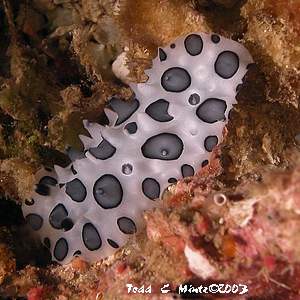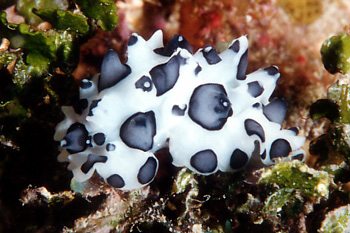

Ceratophyllidia papilligera
(Bergh, 1890)
Order: NUDIBRANCHIA
Suborder: DORIDINA
Superfamily: EUDORIDOIDEA
Family: Phyllidiidae
DISTRIBUTION
Caribbean - West Florida; Gulf of Mexico, Costa Rica; Bahamas: Grand Bahama Island; Cuba; Cayman Islands: Little Cayman; Jamaica; Virgin Islands.
PHOTO
Upper: Roatan, Honduras. February, 2003. Photo: Todd Mintz. Lower: Roatan, Honduras, approx 10-15 meters, November 2001. Approx 30 mm in length. Photo: Boo Nilsson
Formerly known as Phyllidiopsis papilligera, recent studies have concluded that it is better placed in the genus Ceratophyllidia [see Valdes & Gosliner (1999), and message below]. Body white with scattered greyish black spots of varying size. The mantle is covered with short rounded tubercles, those in black spots being black with white tips. Grows to approx 5cm long.
References:
• Bergh, R. 1890 Reports on the results of dredging, under the supervision of Alexander
Agassiz, in the Gulf of Mexico (1877-78) and in the Caribbean Sea (1879-80), by the U. S. Coast Survey Steamer "Blake," Bulletin of the Museum of Comparative Zoology, 19: 155-181, 3 pls.
• Valdes, A. & Gosliner, T.M. (1999): Phylogeny of the radula-less dorids (Mollusca, Nudibranchia), with the description of a new genus and a new family. Zoologica Scripta, 28: 315-360.
Rudman, W.B., 2002 (May 2) Ceratophyllidia papilligera (Bergh, 1890) . [In] Sea Slug Forum. Australian Museum, Sydney. Available from http://www.seaslugforum.net/factsheet/cerapapi
Related messages
-
Ceratophyllidia papilligera from Cuba
From: Elaine, September 22, 2003 -
Ceratophyllidia papilligera from Honduras
From: Marli Wakeling, September 11, 2003 -
Phyllidiopsis papilligera from Honduras
From: Boo Nilsson, May 4, 2002 -
Discodoris atromaculata? from Puerto Rico
From: Joseph Millevolte, March 14, 2002
